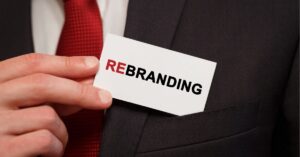Brands aren’t static—they grow, shift, and adapt over time. To manage this evolution effectively, businesses often rely on the 3 types of rebranding to stay relevant, engage new audiences, or recover from missteps. It’s more than just changing logos or colors; it’s about reshaping how your brand is perceived.
In this article, we’ll unpack these three approaches—brand refreshes, full rebrands, and merger or acquisitions—and show how each can drive meaningful growth for your business.
3 Types of Rebranding
Rebranding isn’t just about change, it’s about evolution. Businesses grow, industries shift, and customers expect brands to keep up. Either way, it’s a subtle refresh or a complete transformation, rebranding ensures a company stays relevant, competitive, and aligned with its goals. Even so, not all rebrands are created equal, and choosing the right approach is crucial.
Below are the three types of rebranding, when to use them, and what makes each unique.
Full Rebrand
A full rebrand is a complete transformation from the ground up. It’s used when a company’s identity no longer fits its mission, market, or audience. This isn’t just a visual update , it’s a total reset that involves everything from a new name and logo to a fresh messaging strategy. A full rebrand is often the only solution when a business shifts direction, expands, or needs to escape a negative reputation.
Companies facing major industry changes, declining relevance, or public perception issues often require a full rebrand. It’s a bold move that demands careful planning, but when executed correctly, it breathes new life into a struggling or outdated brand. A well-executed full rebrand realigns the business with its goals and audience, ensuring long-term growth. While the transition can be risky, it allows companies to redefine themselves and stand out in their market.
Key Features:
- Includes a new name, logo, brand identity, and messaging
- Helps attract a new audience or reposition in the market
- Often requires significant marketing efforts to communicate changes
- Requires a strong, consistent rollout to avoid customer confusion
Best When Used:
- A company undergoes a major shift in mission, values, or services
- The current brand has a negative reputation that needs to be left behind
- A business expands into a new market that requires a different identity
- The existing branding no longer resonates with the target audience
Brand Merger or Acquisition
When two brands join forces, their identities can’t stay separate. A merger or acquisition often means different customer bases, messaging styles, and reputations must blend into a single, cohesive brand.
This type of rebrand is about more than just logos, it’s about integrating cultures, values, and market positioning. If handled poorly, it confuses customers and dilutes brand equity, making it harder to build trust.
A successful merger rebrand keeps the best parts of both brands while shaping something new. It requires a deep understanding of what resonates with customers from both companies and how to merge those elements seamlessly. The challenge is balancing familiarity with innovation so the rebrand feels intentional rather than forced. Companies must evaluate what stays, what goes, and how to create a unified identity without alienating loyal customers.
Key Features:
- Often includes a new name, logo, and branding elements
- Requires combining brand identities while maintaining trust
- Aims to unify customer bases and prevent confusion
- Helps streamline operations under one brand umbrella
Best When Used:
- Two companies merge and need a unified identity
- A company acquires another and wants to integrate branding
- The existing brand names or logos create confusion post-merger
- The new entity needs a fresh start without losing recognition
Brand Refresh
A brand refresh is a modernization effort, not a reinvention. It keeps the foundation intact but polishes the surface, updating colors, fonts, logos, or messaging to stay relevant.
Think of it like renovating a home: the structure remains, but the design gets a fresh, modern look. A refresh works well when a brand has strong recognition but needs an update to avoid looking outdated. Businesses that have strong brand equity but feel stale benefit the most from a refresh.
Customers still recognize the brand, but they see it as more current, engaging, and aligned with today’s market. It can involve slight adjustments in messaging, tone, or design without losing the brand’s original essence.
This type of rebranding is low-risk but high-reward, making it a popular choice for companies that want to stay competitive.
Key Features:
- Focuses on visual and messaging updates
- Keeps core identity while improving market relevance
- Often includes updated logos, fonts, and colors
- Can refine tone, voice, and positioning without drastic changes
Best When Used:
- The brand feels outdated but still holds strong recognition
- Competitors have evolved, and the company risks falling behind
- A business wants to appeal to a younger or changing audience
- The company is repositioning slightly but doesn’t need a full overhaul
Why Businesses Rebrand: The Top 5 Reasons
Rebranding isn’t just about aesthetics, it’s a strategic move that helps businesses stay competitive, relevant, and aligned with their goals. Companies don’t wake up one day and decide to change their identity for fun.
There’s always a reason, and in most cases, it’s driven by growth, market shifts, or the need for a fresh start. Below are five of the most common reasons businesses take the leap and rebrand.
1. Outdated Branding
A brand that looks stuck in the past will struggle to connect with modern audiences. Design trends, customer expectations, and industry standards change over time, and brands that don’t evolve risk becoming irrelevant.
An outdated logo, color scheme, or website can make a company seem behind the times, even if its products and services are top-notch. Take Mastercard, for example, dropped the text from its logo, leaving only the iconic overlapping circles to keep things sleek and digital-friendly.
2. Expanding to a New Market
A brand that works in one market may not translate well in another. Expanding internationally, targeting a new demographic, or adding new product lines often requires adjustments to branding.
Messaging, visuals, and even brand names may need to change to resonate with different audiences. Airbnb refined its brand identity to reflect a more global, community-driven experience as it expanded worldwide, ensuring it connected with travelers across cultures.
3. Mergers and Acquisitions
When two companies join forces, they need a unified identity. Operating under multiple brand names creates confusion and dilutes customer trust. A well-executed rebrand helps align the businesses under a single vision, ensuring consistency in messaging and experience.
Verizon was born from the merger of Bell Atlantic and GTE, adopting a fresh name and logo to establish a new, recognizable presence in the telecommunications industry.
4. Reputation Issues
A brand with a damaged reputation sometimes needs a clean slate. Negative press, legal troubles, or public perception problems can make it difficult to recover without a significant change.
A rebrand allows companies to redefine themselves, shifting the conversation away from past issues. Meta rebranded from Facebook to distance itself from privacy scandals, signaling a broader focus on the metaverse rather than just social media.
5. Shifting Business Model or Values
As companies grow, their mission and focus often change. A brand that started in one niche may expand its offerings, making its original identity too limiting. Rebranding helps reposition the company to reflect its current goals and values.
Dunkin’ dropped “Donuts” from its name to emphasize its broader menu and modernize its image, making it more than just a coffee-and-donut shop.
Real-World Rebrands: Three Transformations That Worked
Brand Merger or Acquisition – Disney & Pixar
When Disney acquired Pixar in 2006, it wasn’t just about expanding its animation portfolio, it was about revitalizing Disney’s storytelling magic. At the time, Disney Animation was struggling with hits, while Pixar dominated with fresh, emotionally rich stories.
Instead of absorbing Pixar’s identity, Disney preserved its creative autonomy while subtly integrating its innovative storytelling approach into Disney Animation. The result? A resurgence of Disney’s animated success, with films like Frozen and Moana proving that the merger strengthened both brands rather than diluting them.
Brand Refresh – Burger King
Burger King’s 2021 rebrand was a masterclass in modernizing without losing nostalgia. The fast-food giant ditched its outdated, 3D-glossy logo for a sleeker, retro-inspired design that felt fresh yet familiar.
Alongside a new visual identity, it revamped packaging, uniforms, and store aesthetics to embrace a bold, playful, and more digital-friendly brand presence. This refresh wasn’t just cosmetic, it reinforced Burger King’s commitment to quality ingredients and a more engaging customer experience, positioning it as a serious competitor in the fast-food wars.
Full Rebrand – Old Spice
Old Spice was once seen as a dated brand associated with older generations. In the early 2010s, it flipped the script with a bold, humorous, and high-energy rebrand that made it relevant to a younger audience.
The now-iconic “Smell Like a Man, Man” campaign, featuring absurd yet memorable ads, redefined Old Spice as a modern, edgy brand. The rebrand skyrocketed sales, turning an old-school deodorant into a must-have for younger consumers, proving that a full transformation can breathe new life into a struggling brand.
Types of Rebrand: Final Thoughts
Rebranding isn’t just about looking good, it’s about staying relevant and making sure people still connect with what you stand for. Some brands just need a refresh to keep things modern, while others go all in with a total transformation.
The key is knowing when to tweak, when to evolve, and when to start fresh. A smart rebrand builds trust, strengthens identity, and keeps your business ahead of the curve. Stay the same for too long, and you risk being forgotten.
Frequently Asked Questions
How to structure a rebrand
A successful rebrand starts with research, defining goals, and understanding the target audience. The process includes updating visuals, refining messaging, and ensuring consistency across all platforms. A strong rollout strategy is essential to communicate the changes effectively and maintain customer trust.
Why is rebranding risky
Rebranding can confuse customers, weaken brand recognition, or fail to resonate with the audience. Poor execution may lead to lost trust or a decline in sales. A well-planned strategy, market research, and clear communication help minimize risks and ensure a smooth transition.
What are the levels of rebranding
Rebranding varies in scope, from a brand refresh to a full transformation. A refresh involves minor updates like logos and messaging, while a full rebrand changes the name, identity, and positioning. The level depends on business goals, audience shifts, or reputation challenges.
Related:
- Mastering the Art of Rebranding: Ignite Powerful Change
- Rebranding vs Repositioning: Enhance Your Brand’s Impact Now
- Brand Extensions vs. Sub-Brands: Choosing the Right Strategy for Growth

We empower people to succeed through information and essential services. Do you need help with something? Contact Us.
Want a heads-up once a week whenever a new article drops?







